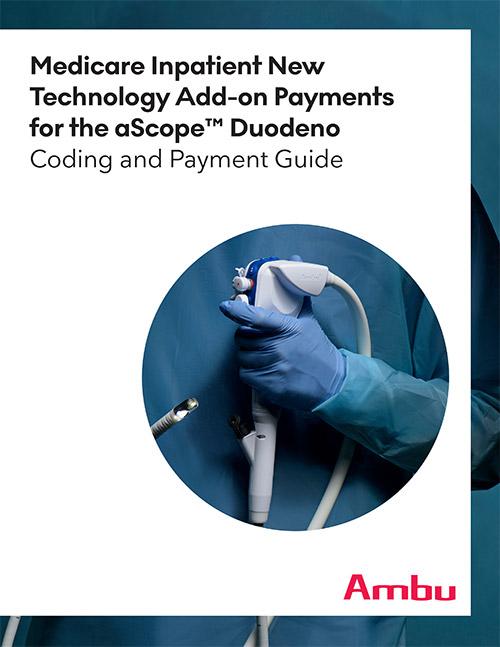Reimbursement
The Centers for Medicare and Medicaid Services approved a new technology add-on payment for single-use duodenoscopes — reducing and, in some cases, removing perceived financial barriers to exploring disposable endoscopes as a viable long-term patient care solution.

Repayment
Historically, hospitals have been somewhat reluctant to embrace new medical devices, says Kristen O’Brien, vice president at McDermott+Consulting. It’s not that physicians are averse to new technologies. Rather, the problem more often lies with costs and reimbursements.
 While new medical devices are often more expensive than existing devices, providers normally don’t receive any additional reimbursement from payers like Medicare.
While new medical devices are often more expensive than existing devices, providers normally don’t receive any additional reimbursement from payers like Medicare.
“There’s very little financial incentive to use the new technology, because they’re still getting paid the same rate,” says O’Brien, an expert in healthcare regulation and policy. “A new device requires new workflows, and changes to purchasing practices. And it’s hard to point to the added benefit if a hospital isn’t already using the device. There are multiple hurdles to clear.”
Recently, the Centers for Medicare and Medicaid Services (CMS) approved a new technology add-on payment (NTAP) for single-use duodenoscopes. This significantly reduces and, in some cases, can remove the perceived financial burden of exploring single-use duodenoscopes as a viable long-term patient care solution.
What Is NTAP?
CMS approves only a handful of NTAP designations each year, making it a little-known feature even within healthcare circles. This recent NTAP approval means CMS will now provide hospitals with an additional device reimbursement when hospitals use single-use duodenoscopes such as the Ambu aScope Duodeno for eligible cases in inpatient settings.
The NTAP payment is in addition to the standard Medicare Severity Diagnosis-Related Group (MS-DRG) payment amount, and an NTAP designation lasts no more than three years.
“Because Medicare pays in a bundled payment system for treatments, it doesn’t account for the costs associated with something that is new,” O’Brien says. “The add-on payment recognizes that the new technology has implicit costs, like the change in workflows or training processes, and then also the cost of the technology itself.”
To qualify for NTAP approval, a medical technology must meet three criteria. First, it must be new, and cannot be “substantially similar” to existing technologies. Next, there’s a cost component: The technology must be inadequately paid under the existing MS-DRG system. Finally, the solution must significantly improve clinical outcomes for patient populations when compared with currently available treatments.
This last point is, perhaps, the most important of all, as it represents CMS’s recognition of the clear clinical benefits of single-use duodenoscopes. While the technology provides a number of long-term benefits around cost and efficiency, these benefits are secondary to the reduced risk of patient infection associated with single-use duodenoscopes.
“The add-on payment encourages device manufacturers to create something new,” O’Brien explains. “If they can show that their products are better and new and novel, they get higher payments. It encourages the device makers to think outside the box and push for new services.”
The duodenoscope NTAP payments went into effect on Oct. 1, 2021, meaning that healthcare providers can take advantage of them immediately. Single-use duodenoscopes were also approved for a transitional pass-through payment (TPT) in July 2020. A TPT designation is similar to an NTAP designation but applies to outpatient care.
That same month, Ambu’s aScope Duodeno endoscope received FDA clearance and was also granted Breakthrough Device Designation. The FDA's Breakthrough Device Program is reserved for certain medical devices that provide for more effective treatment or diagnosis of life-threatening or irreversibly debilitating diseases or conditions. This program is intended to help patients receive more timely access to these medical devices by expediting their development, assessment, and review by FDA.
Medicare Inpatient New Technology Add-on Payments for the aScope™ Duodeno: Coding and Payment Guide
Why NTAP Matters
NTAP is a financial game changer for healthcare organizations interested in making single-use endoscopy a part of their operations. The add-on payment is specifically designed to put cutting-edge technologies such as the Ambu aScope Duodeno on an even (or nearly even) financial level with traditional solutions.
For healthcare providers, this means that they can unlock the benefits of single-use scopes without taking a financial hit. The specific figures will vary from case to case, but typically the NTAP reimbursement will make the use of single-use duodenoscopes essentially cost-neutral.
This is important because most healthcare providers already have significant resources invested into expensive reusables. Many hospital administrators are unwilling to let this infrastructure sit idle if it means they must also incur an additional cost for single-use scopes.
Think of it this way: If you already own a car, you’re unlikely to start taking Ubers all the time, even if it’s more convenient and cuts down on your long-term maintenance costs. But if Ubers were suddenly free, you would probably take them everywhere, rather than putting unnecessary miles on your car.
Looking Ahead
In the short term, healthcare organizations can use the NTAP reimbursements to ensure that they have a steady supply of flexible duodenoscopes. By keeping a supply of (now cost-neutral) single-use duodenoscopes on hand, they can prevent procedure delays associated with equipment reprocessing. This, in turn, should boost patient and provider satisfaction, and also prevent lost revenue.
Over the long run, single-use endoscopes can not only improve patient care but can also insulate healthcare organizations from a number of financial risks. For instance, duodenoscopes such as the Ambu aScope Duodeno enable hospitals to use a variable, rather than a fixed, cost model. This becomes important when procedure counts fluctuate over time.
Rather than running the risk of over- or under-investing in reusable scopes, administrators can be confident that every dollar they spend on flexible endoscopes will go to good use. And if organizations switch over to single-use endoscopes completely, they can recapture hospital space and staff time that are currently dedicated to reprocessing.
Given the clinical benefits of single-use flexible duodenoscopes, the NTAP designation can be read as a sign of a coming shift in the industry, away from reusables and toward products such as the Ambu aScope Duodeno. By taking advantage of the additional reimbursement, hospitals can gain risk-free experience and prepare themselves for the future.
Single-Use Endoscopy
Check out the latest in endoscopy research and best practices at this learning center by Ambu USA.








